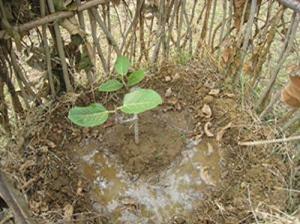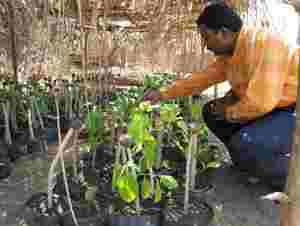Biswajit Mohanty
Other projects
This project seeks to protect the hanging roots from destruction due to nibbling by goats as well as by cutting by human beings.

A young banyan tree sapling with tree guard planted at Dandiri.
This project was first started in November, 2003 with the help of a small grant from RSG. We took up 50 banyan trees for protection. We got a continuation grant in 2005 and we adopted an additional number of 30 trees. For two years, we protected 80 trees and also planted new banyan saplings to increase the local population of the species.

Mr. Biswajit Mohanty inspecting the banyan seedling nursery at Dandiri village.
With the help of this booster grant we shall protect the hanging roots of 100 new banyan trees as well as the 30 trees adopted during the previous year. The hanging roots of the first 50 trees adopted three years ago when we launched the project have struck ground and do not need further protection.
Only trees with hanging roots suspended a few feet from the ground would be protected. The Banyan tree (Ficus bengalensis ) is a commonly distributed tree in India and is found in villages as well as cities. This tree is extremely critical for local wildlife species since it serves as a refuge and food source for a wide variety of avifauna, reptiles and mammals. The tree is revered as a holy tree by Hindus.
Banyan trees can only survive and grow if their hanging roots are able to strike the ground for support since they have extended branches which derive support from the hanging roots. The tree also obtains its food from the hanging roots provided it strikes the ground.
This project seeks to protect the hanging roots from destruction due to nibbling by goats as well as by cutting by human beings. Protection of these roots for at least two years would enable them to strike the ground as we have seen during the last three years.
We shall partner with the local community for this project and shall educate them about the tremendous importance of the banyan tree. Local animators would be monitoring the condition of the protective fences, carry out a door to door campaign and also organize local meetings Audio visual aids including posters, wall paintings, stickers and illustrated brochures would be used to carry out the awareness campaign. Signboards in local language which would have messages would be put up on the trees. School children shall be motivated through quizzes and meets for banyan tree protection. Planting of 300 new saplings would be taken up.